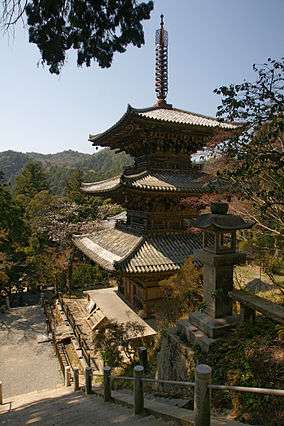Kasai, Hyōgo
| Kasai 加西市 | ||
|---|---|---|
| City | ||
| ||
 Location of Kasai in Hyōgo Prefecture | ||
 Kasai Location in Japan | ||
| Coordinates: 34°56′N 134°50′E / 34.933°N 134.833°ECoordinates: 34°56′N 134°50′E / 34.933°N 134.833°E | ||
| Country | Japan | |
| Region | Kansai | |
| Prefecture | Hyōgo Prefecture | |
| Government | ||
| • Mayor | Kazuhira Nishimura (since June 2011) | |
| Area | ||
| • Total | 150.22 km2 (58.00 sq mi) | |
| Population (August 31, 2016) | ||
| • Total | 45,126 | |
| • Density | 300.4/km2 (778/sq mi) | |
| Symbols | ||
| • Tree | Live oak | |
| • Flower | Salvia | |
| Time zone | Japan Standard Time (UTC+9) | |
| Website |
www | |
Kasai (加西市 Kasai-shi) is a city located in Hyōgo Prefecture, Japan. The city was founded on April 1, 1967 when the towns of Hōjō, Izumi and Kasai (former) were merged to create the city of Kasai.
As of August 31, 2016, the city has an estimated population of 45,126 and a population density of 300.40 persons per km². The total area is 150.22 km².
Kasai is famous for the Gohyaku-Rakan statues (the 500 disciples of Buddha) in Hōjō. Hōjō is also home to Maruyama Park, where one can find the world's largest globe clock (Guinness certified) and reputedly the world's longest roller slide. Other sights in Kasai are the Hyōgo Prefectural Flower Center, the Princess Nehime burial mound, and Ichijō-ji Temple near Zenbo junior high school. Kasai has two festivals: the Saisai festival in early August and the Sekku festival in early April.
Kasai is the sister city of Pullman, Washington USA.
Transport
Kasai is highly dependent on private vehicles as the main form of transportation.
Public Transport
Public transport is an inter-prefecture highway bus and a private railroad (the Hōjō Tetsudō), inter-city bus (Shinki bus), KIX airport limousine bus (Hakuro bus), domestic-bus (Kasai city community bus, Happy bus) and Taxi.
Culture
Architecture
- Ichijō-ji - the temple's pagoda, completed in 1171, is a National Treasure of Japan.
 Ichijō-ji's pagoda
Ichijō-ji's pagoda
External links
 Media related to Kasai, Hyōgo at Wikimedia Commons
Media related to Kasai, Hyōgo at Wikimedia Commons- Kasai City official website (Japanese)
